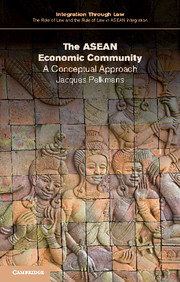Book contents
- Frontmatter
- Contents
- List of figures
- List of tables
- List of boxes
- General editors’ preface
- 1 Introduction and purpose
- 2 Foundations of economic integration fundamentals, stages and credibility
- 3 Conceptual foundation of the ASEAN Economic Community
- 4 Implementation of the AEC: progress in adopting instruments from the Roadmap
- 5 A reality check: comparing the AEC and NAFTA on substance
- 6 Options for the AEC and their practical implications
- 7 Conclusions
- Executive summary
- Appendix 1
- References
- Index
1 - Introduction and purpose
Published online by Cambridge University Press: 05 March 2016
- Frontmatter
- Contents
- List of figures
- List of tables
- List of boxes
- General editors’ preface
- 1 Introduction and purpose
- 2 Foundations of economic integration fundamentals, stages and credibility
- 3 Conceptual foundation of the ASEAN Economic Community
- 4 Implementation of the AEC: progress in adopting instruments from the Roadmap
- 5 A reality check: comparing the AEC and NAFTA on substance
- 6 Options for the AEC and their practical implications
- 7 Conclusions
- Executive summary
- Appendix 1
- References
- Index
Summary
Understanding ASEAN's economic integration model is a genuine challenge. A fundamental reason why conceptual and other difficulties arise in the case of the ASEAN Economic Community (AEC) is that ASEAN architects observe two stylised (regional) economic integration approaches in the world which they do not want to pursue: the ‘EU model’, which is supranational, far too ambitious and also to a degree ‘open-ended’ in terms of further ambitions, and the classical free trade area (FTA) approach, even when upgraded a little nowadays. Another reason for conceptual puzzles is found in ASEAN's strategic (development) preference of hooking up to global value chains, without a firm view on how such a strategy relates to ‘deep’ economic integration. Within the framework of the ASEAN Integration through Law project, the purpose of the present monograph is to try to make the ASEAN economic integration model intelligible by applying a conceptual approach. This conceptual approach is drawn out in considerable detail, but it is also ‘tested’ by providing a wealth of factual detail about how ASEAN implements the AEC. The merit of the conceptual approach is, above all, that the numerous technical and often highly specific measures, as well as the many ASEAN ‘principles’ and ‘guidelines’, not to speak of detailed Roadmaps, can be understood in context and their economic and practical significance for market players better appreciated. Given the ASEAN ‘way’ of building up commitments, whether for the former AFTA or now for the AEC, it is exceedingly difficult to make (over 500) elements of the AEC Roadmap intelligible and give them a ‘place’. However, right from the start, it is crucial to appreciate that the AEC is based on two concepts, presented as parallel: the ‘single market’ and (ASEAN as a) ‘production base’ for segments of global value chains. Whereas the single ASEAN market has at least been defined with respect to some key properties (such as ‘free flows’), this is not the case for the ‘production base’. It is also exceedingly difficult to trace authoritative statements about, let alone a legal basis for, the political priority of one concept over the other, or how the two concepts are linked, say, by some minimum overlap of measures or otherwise.
- Type
- Chapter
- Information
- The ASEAN Economic CommunityA Conceptual Approach, pp. 1 - 7Publisher: Cambridge University PressPrint publication year: 2016

